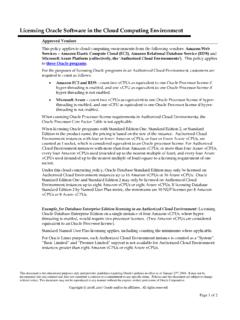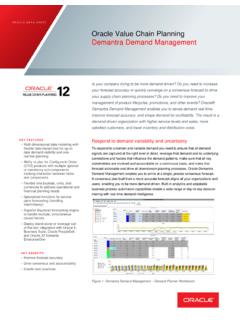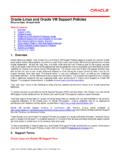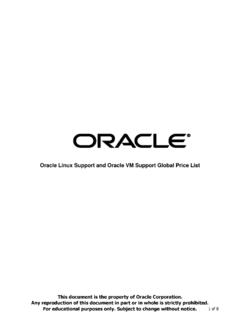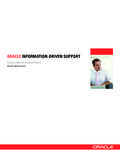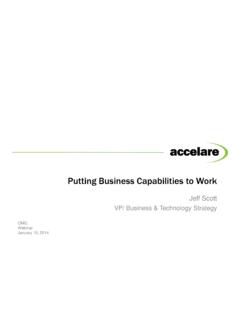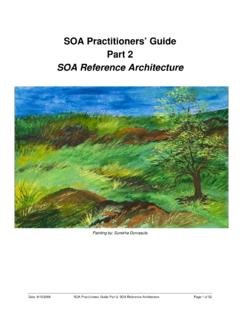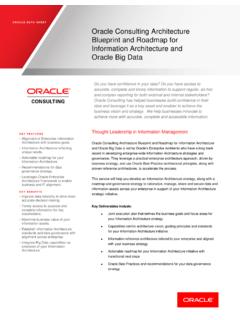Transcription of ODI Architecture Overview - Oracle
1 An Oracle White Paper February 2014. Oracle Data Integrator 12c Architecture Overview Oracle Data Integrator 12c Architecture Overview Introduction Oracle Data Integrator (ODI) 12c is built on several components all working together around a centralized metadata repository. These components graphical modules, runtime agents and web- based interfaces in conjunction with other advanced features make ODI a lightweight, state of the art data integration platform. This technical brief describes the Oracle Data Integrator 12c Architecture in detail. Architecture Overview The Oracle Data Integrator Architecture is organized around a modular repository, which is accessed in client-server mode by components such as the ODI Studio and execution Agents that are written entirely in Java.
2 The Architecture also incorporates web-based components such as the Management Pack for Oracle Data Integrator which integrates with the Oracle enterprise Manager Cloud Control infrastructure or the ODI Console which enables users to access metadata information through a Web interface. ODI Studio ODI Studio provides four graphical Navigators for managing ODI artifacts: Designer, Operator, Topology and Security. ODI Studio offers an easy to use graphical user interface and can be installed on various platforms such as Microsoft Windows or Linux. Figure 1 - ODI Studio Navigators connect to the repository 2. Oracle Data Integrator 12c Architecture Overview ODI Studio Navigators are as follows: Designer defines declarative rules for data transformation and data integrity.
3 All project development takes place in this module; this is where database and application metadata are imported and defined. The Designer module uses metadata and rules to generate data integration scenarios or load plans for production. This is the core module for developers and metadata administrators. Operator manages and monitors data integration processes in production. It is designed for operators and shows execution logs with error counts, the number of rows processed, execution statistics, the actual code that is executed, and so on. At design time, developers can also use the Operator module for troubleshooting purposes. Topology defines the physical and logical Architecture of the infrastructure. The infrastructure or projects administrators register servers, database schemas and catalogs, and agents in the master repository through this module.
4 Security manages user profiles, roles and their privileges. Security can also assign access authorization to objects and features. Security administrators generally use this module. All modules store their information in the centralized repository. Runtime Components: The Agents At runtime, the Agent coordinates the execution of the ODI sessions. It retrieves the code stored in the ODI repository, connects to the various source and target systems and orchestrates the overall data integration process. There are three types of Agents in Oracle Data Integrator 12c: Standalone Agents can be installed on the source or target systems and require a Java Virtual Machine. Colocated Standalone Agents can be installed on the source or target systems as well. They can be managed using Oracle enterprise Manager and must be configured with an Oracle WebLogic domain.
5 Colocated Standalone Agents can run on a separate machine from the Oracle WebLogic Administration Server. Java enterprise Edition (Java EE) Agents are deployed on Oracle WebLogic Server and can benefit from the application server layer features such as clustering for High Availability requirements. Java EE Agents can be managed using Oracle enterprise Manager. With the Extract-Load Transform (E-LT) Architecture , the Agent rarely performs any transformation. It simply retrieves code from the ODI repository and then requests database servers, operating systems, or scripting engines to execute that code. When the execution is completed, the Agent updates the execution logs in the repository and then reports error messages and execution statistics. Users can review the execution logs from the Operator Navigator or from Oracle enterprise Manager.
6 It is important to understand that although the Agent can act as a transformation engine, it is rarely used for that purpose. Agents are installed at tactical locations in the information system to coordinate 3. Oracle Data Integrator 12c Architecture Overview the integration processes and leverage existing systems. They are multithreaded, load-balanced, lightweight components in this distributed integration Architecture . Figure 2 - Standalone Runtime Components Repositories The Repository consists of one or more Master Repositories and typically several Work Repositories. These repositories are sets of tables stored in relational database management systems such as Oracle , Microsoft SQL Server, IBM DB2 or MySQL. All objects that the ODI modules configure, develop, or use are stored in one of these repositories, and are accessed in client-server mode by the various components of the Architecture .
7 The Master Repository contains the security information (user profiles, roles and privileges), the topology information (definitions of technologies and servers), and the source code for all versions of all ODI objects ever versioned. The information contained in the Master Repository is maintained with Topology and Security Navigators in ODI Studio as well as with ODI Console. 4. Oracle Data Integrator 12c Architecture Overview Figure 3 - Master repository and Work repositories Project objects are stored in a Work Repository. Several Work Repositories can coexist in the same installation. This is useful for maintaining separate environments or to reflect a particular versioning lifecycle for example, development, quality assurance, and production environments.
8 A work repository stores information for Models ( metadata) including datastores, columns, data integrity constraints, cross references, data lineage and impact analysis Projects including mappings, packages, procedures, folders, knowledge modules, and variables Runtime information including scenarios, load plans, scheduling information, and execution logs Users manage the content of a work repository with the Designer and Operator Navigators in ODI. Studio. The Agent at runtime also accesses work repositories. When a Work Repository is used only to store execution information (typically for production purposes), it is called an execution repository. An execution repository can be accessed at runtime with the Operator Navigator, the Agents and by Oracle enterprise Manager.
9 It is important to remember that each Work Repository is always attached to one and only one master repository. 5. Oracle Data Integrator 12c Architecture Overview Management Pack for Oracle Data Integrator The Management Pack for Oracle Data Integrator leverages Oracle enterprise Manager Cloud Control best-in-class application performance management, service level management and configuration management capabilities to provide a centralized management solution for Oracle Data Integrator. The Management Pack for ODI allows administrators to monitor and manage all of their ODI. components along with other Oracle products from a single administration console. In addition, it provides operators and developers end-to-end execution monitoring and drill-down capabilities into Oracle databases activity.
10 End users can also leverage powerful alerting and notification capabilities to manage their Service Level Agreements (SLA). Figure 4 - Management Pack for Oracle Data Integrator ODI Console ODI Console is a Java EE application that can be deployed in a WebLogic domain and provides administrators with the ability to view and edit Topology objects such as Data Servers, Physical and Logical Schemas as well as to manage their repositories. In addition ODI Console allows users to browse Design-Time objects, including projects or models. Through its comprehensive Web interface, users can see flow maps and data lineage diagrams, trace the source of all data, and even drill down to the field level to understand the transformations used to build the data. 6. Oracle Data Integrator 12c Architecture Overview Other Features Oracle Data Integrator also includes the following components and features: Knowledge Modules make it possible to quickly and easily integrate technologies, databases, and applications.


